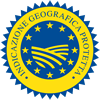Description
The Tiroler Speck PGI is a delicatessen product obtained from processing of pork legs with the addition of some natural flavouring.
Production Area
The Tiroler Speck PGI production area lies within the federal state of Tirol.
Production Method
The leg of pork is deboned and reduced to pieces, then are the pieces are salted and flavoured with various herbs and spices including bay leaves, pepper and nutmeg. The pieces are then left to rest for about 30 days after which they begin the smoking stage. To be smoked, the pieces of meat are placed on iron frames inside large fireplaces fuelled by chips of maple and beech. The smoking process takes about 10 days and is carried out at temperatures not exceeding 20°C. Once this phase is complete, the smoked product is seasoned for about five months.
Appearance and Flavour
Tiroler Speck PGI has a flattened and elongated shape. It does not have a great deal of fat, the colour is rather pink and the aroma and flavour are pleasantly spiced and smoked.
History
Tiroler Speck PGI is the result of an ancient tradition, handed down from generation to generation. The practice of preparing and smoking pork meat on maple and beech wood and chips was a useful method for preserving meat for many years, since it was not possible to keep the meat fresh. Production techniques have been retained and refined over time, keeping the distinctive taste of this product alive and improving its quality.
Gastronomy
Tiroler Speck PGI should be stored in a dry place at room temperature for a period of about 50-90 days. It is consumed in its natural state, accompanied by bread, but it can also be used as an ingredient in many culinary preparations. Is usually eaten as an appetizer or as a main course accompanied with cheese and wine. A traditional use is in the tasty local recipe Tyrolese Baked potatoes.
Marketing
The product is sold as Tiroler Speck PGI. It is marketed in one piece, steaks or slices protected by food wrapping or in vacuum sealed trays.
Distinctive Features
Tiroler Speck PGI is taken in its raw state over and controlled by the speck expert. It is then subjected to a thorough inspection that includes examination of the cut characteristics and the percentage of fat present. To ensure that the quality of the product is first-rate, only pieces that pass this analysis are processed further and then marketed.






